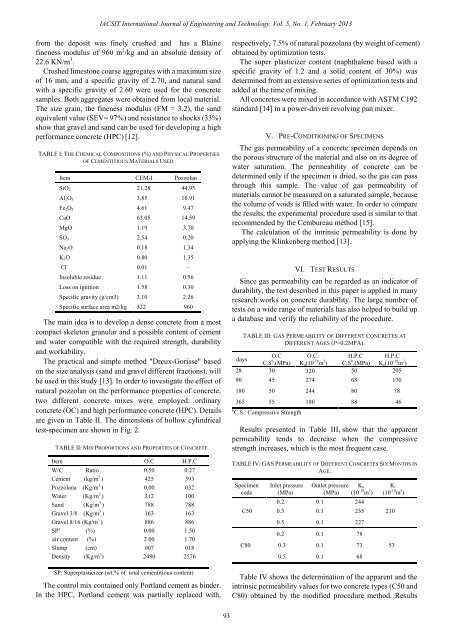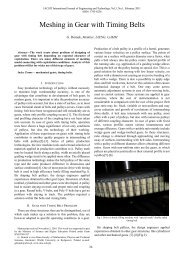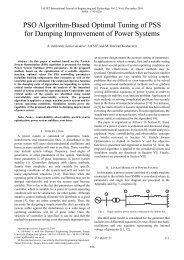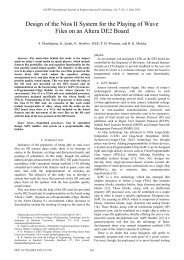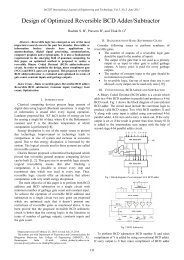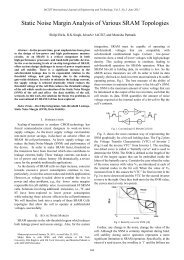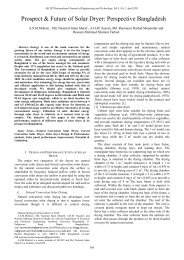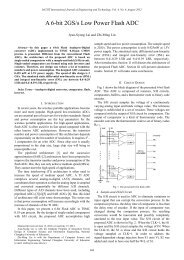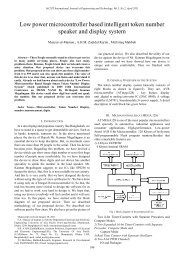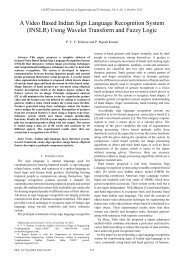A Modified Test Procedure to Measure Gas Permeability of ... - IJET
A Modified Test Procedure to Measure Gas Permeability of ... - IJET
A Modified Test Procedure to Measure Gas Permeability of ... - IJET
You also want an ePaper? Increase the reach of your titles
YUMPU automatically turns print PDFs into web optimized ePapers that Google loves.
IACSIT International Journal <strong>of</strong> Engineering and Technology, Vol. 5, No. 1, February 2013<br />
from the deposit was finely crushed and has a Blaine<br />
fineness modulus <strong>of</strong> 960 m 2 /kg and an absolute density <strong>of</strong><br />
22.6 KN/m 3 .<br />
Crushed limes<strong>to</strong>ne coarse aggregates with a maximum size<br />
<strong>of</strong> 16 mm, and a specific gravity <strong>of</strong> 2.70, and natural sand<br />
with a specific gravity <strong>of</strong> 2.60 were used for the concrete<br />
samples. Both aggregates were obtained from local material.<br />
The size grain, the fineness modulus (FM = 3.2), the sand<br />
equivalent value (SEV= 97%) and resistance <strong>to</strong> shocks (33%)<br />
show that gravel and sand can be used for developing a high<br />
performance concrete (HPC) [12].<br />
TABLE I: THE CHEMICAL COMPOSITIONS (%) AND PHYSICAL PROPERTIES<br />
OF CEMENTITIOUS MATERIALS USED<br />
Item CEM-I Pozzolan<br />
SiO 2 21.28 44.95<br />
Al 2 O 3 3.85 16.91<br />
Fe 2 O 3 4.61 9.47<br />
CaO 63.05 14.59<br />
MgO 1.19 3.70<br />
SO 3 2.54 0.20<br />
Na 2 O 0.18 1.34<br />
K 2 O 0.80 1.35<br />
Cl - 0.01 –<br />
Insoluble residue 1.11 0.56<br />
Loss on ignition 1.58 0.30<br />
Specific gravity (g/cm3) 3.10 2.26<br />
Specific surface area m2/kg 322 960<br />
The main idea is <strong>to</strong> develop a dense concrete from a most<br />
compact skele<strong>to</strong>n granular and a possible content <strong>of</strong> cement<br />
and water compatible with the required strength, durability<br />
and workability.<br />
The practical and simple method "Dreux-Gorisse" based<br />
on the size analysis (sand and gravel different fractions), will<br />
be used in this study [13]. In order <strong>to</strong> investigate the effect <strong>of</strong><br />
natural pozzolan on the performance properties <strong>of</strong> concrete,<br />
two different concrete mixes were employed: ordinary<br />
concrete (OC) and high performance concrete (HPC). Details<br />
are given in Table II. The dimensions <strong>of</strong> hollow cylindrical<br />
test-specimen are shown in Fig. 2.<br />
TABLE II: MIX PROPORTIONS AND PROPERTIES OF CONCRETE<br />
Item O.C H.P.C<br />
W/C Ratio 0.50 0.27<br />
Cement (kg/m 3 ) 425 393<br />
Pozzolana (Kg/m 3 ) 0.00 032<br />
Water (Kg/m 3 ) 212 100<br />
Sand (Kg/m 3 ) 788 788<br />
Gravel 3/8 (Kg/m 3 ) 163 163<br />
Gravel 8/16 (Kg/m 3 ) 886 886<br />
SP a (%) 0.00 1.50<br />
air content (%) 2.00 1.70<br />
Slump (cm) 007 018<br />
Density (Kg/m 3 ) 2480 2576<br />
SP: Superplasticizer (wt.% <strong>of</strong> <strong>to</strong>tal cementitious content)<br />
The control mix contained only Portland cement as binder.<br />
In the HPC, Portland cement was partially replaced with,<br />
respectively, 7.5% <strong>of</strong> natural pozzolana (by weight <strong>of</strong> cement)<br />
obtained by optimization tests.<br />
The super plasticizer content (naphthalene based with a<br />
specific gravity <strong>of</strong> 1.2 and a solid content <strong>of</strong> 30%) was<br />
determined from an extensive series <strong>of</strong> optimization tests and<br />
added at the time <strong>of</strong> mixing.<br />
All concretes were mixed in accordance with ASTM C192<br />
standard [14] in a power-driven revolving pan mixer.<br />
V. PRE-CONDITIONING OF SPECIMENS<br />
The gas permeability <strong>of</strong> a concrete specimen depends on<br />
the porous structure <strong>of</strong> the material and also on its degree <strong>of</strong><br />
water saturation. The permeability <strong>of</strong> concrete can be<br />
determined only if the specimen is dried, so the gas can pass<br />
through this sample. The value <strong>of</strong> gas permeability <strong>of</strong><br />
materials cannot be measured on a saturated sample, because<br />
the volume <strong>of</strong> voids is filled with water. In order <strong>to</strong> compare<br />
the results, the experimental procedure used is similar <strong>to</strong> that<br />
recommended by the Cembureau method [15].<br />
The calculation <strong>of</strong> the intrinsic permeability is done by<br />
applying the Klinkenberg method [13].<br />
VI. TEST RESULTS<br />
Since gas permeability can be regarded as an indica<strong>to</strong>r <strong>of</strong><br />
durability, the test described in this paper is applied in many<br />
research works on concrete durability. The large number <strong>of</strong><br />
tests on a wide range <strong>of</strong> materials has also helped <strong>to</strong> build up<br />
a database and verify the reliability <strong>of</strong> the procedure.<br />
TABLE III: GAS PERMEABILITY OF DIFFERENT CONCRETES AT<br />
DIFFERENT AGES (P=0.2MPA).<br />
O.C O.C. H.P.C H.P.C<br />
days<br />
C.S b .(MPa) K a (10 -18 m 2 ) C.S b .(MPa) K a (10 -18 m 2 )<br />
28 30 320 50 205<br />
90 45 274 68 170<br />
180 50 244 80 78<br />
365 55 180 88 46<br />
b C.S.: Compressive Strength<br />
Results presented in Table III, show that the apparent<br />
permeability tends <strong>to</strong> decrease when the compressive<br />
strength increases, which is the most frequent case.<br />
TABLE IV: GAS PERMEABILITY OF DIFFERENT CONCRETES SIX MONTHS IN<br />
AGE.<br />
Specimen<br />
code<br />
Inlet pressure<br />
(MPa)<br />
Outlet pressure<br />
(MPa)<br />
K a<br />
((10 -18 m 2 )<br />
0.2 0.1 244<br />
K i<br />
(10 -18 m 2 )<br />
C50 0.3 0.1 235 210<br />
0.5 0.1 227<br />
0.2 0.1 78<br />
C80 0.3 0.1 73 53<br />
0.5 0.1 68<br />
Table IV shows the determination <strong>of</strong> the apparent and the<br />
intrinsic permeability values for two concrete types (C50 and<br />
C80) obtained by the modified procedure method. Results<br />
93


